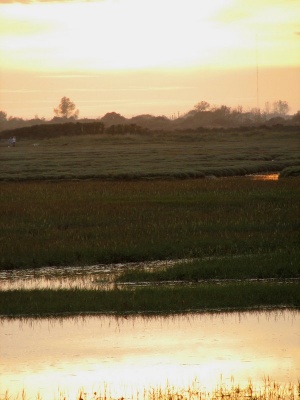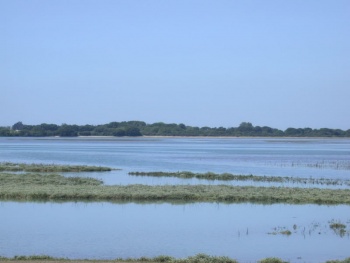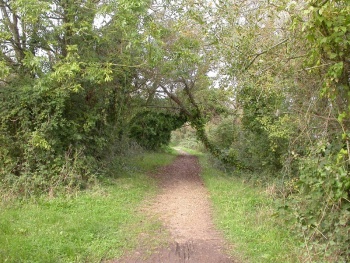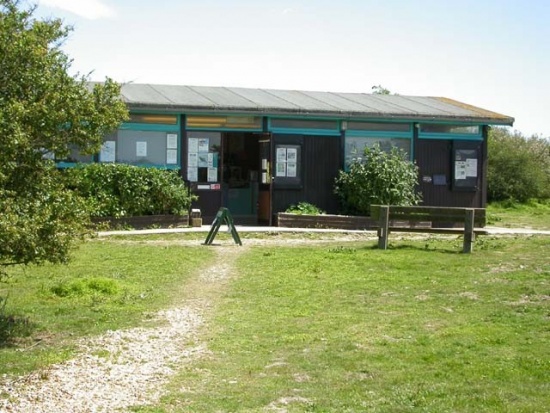
Overview
Pagham Harbour and the surrounding area make up one of the most productive and easily watched birding areas on the English south coast. It is of national importance for a number of species and this Local Nature Reserve is also designated a Site of Special Scientific Interest, a Special Protection Area, an Important Bird Area and a Ramsar Site.
A variety of habitats can be found here centred around the harbour itself which consists of a large area of mudflats and saltmarsh with extensive Spartina beds.
The harbour banks and sea walls provide excellent vantage points to view both the harbour and the surrounding farmland.
Birds
Notable Species
Breeding species include Little Tern, Ringed Plover and Oystercatcher on the shingle beaches, Northern Lapwing and Common Redshank on the farmland, Reed Warbler and Sedge Warbler and Reed Bunting in the reedbeds and Little Grebe, Mallard, Mute Swan, Moorhen and Mute Swan on the pools.
The fields, scrubland, hedgerows and woods hold a wide variety of breeding species including both partridges and Common Pheasant, all three British woodpeckers, Tree Sparrow and Corn Bunting.
Eurasian Sparrowhawk and Common Kestrel are resident in the area as well as Tawny Owl, Little Owl and Western Barn Owl. Although most of the waders are passage and winter visitors there are usually a small number of non-breeding individuals of various species present in summer.
Autumn passage begins before the middle of July for waders and the variety of species to be seen here when migration is fully underway can be astounding. All the more regular species can be seen as well as scarcer migrants such as Little Ringed Plover, Little Stint, Curlew Sandpiper and Spotted Redshank.
Offshore there are movements of Northern Gannet, terns and skuas, usually Arctic Skua but also Great Skua and Pomarine Skua, most obvious with strong winds from the southeast. Little Gull and Black Tern are also regular at this time of year and numbers of Yellow-legged Gull in late summer are increasing making this now one of the best sites in the country for this newly recognised species.
Raptors such as Marsh Harrier, Common Buzzard, Osprey and Northern Hobby all occur on passage.
Passerine migrants are also varied with all the commoner species such as Whinchat, Northern Wheatear, Yellow Wagtail and a range of warblers. Scarcer migrants such as Wryneck and Hoopoe, Black Redstart, Common Firecrest and Golden Oriole occur with surprising regularity as well as the occasional rarer species. Little Egret is now a regular feature at Pagham Harbour with more than 40 birds present at times.
In winter Pagham Harbour is of international importance for Dark-bellied Brent Goose with about 3,000 regularly seen, usually with a small number of Pale-bellied Brent Goose, and nationally important for birds such as Great Cormorant, Northern Pintail, which can exceed 500, Grey Plover and Black-tailed Godwit.
Other waterfowl present include Common Shelduck, Eurasian Wigeon and Common Teal with Red-breasted Merganser, Greater Scaup and Common Eider present at high tide. Red-necked Grebe and Slavonian Grebe also occur. These more marine species can also be seen on the sea outside the harbour often joined by divers.
Like many other southern English sites the numbers and variety of waterfowl increases with severe weather and grey geese and wild swans can then be seen at Pagham. Wintering waders include both godwits, Ruff and a few Pied Avocet. The large concentrations of birds inevitably attract raptors and Hen Harrier and Merlin are regular, also Short-eared Owl.
All the commoner gull species are present and sometimes Glaucous Gull and Mediterranean Gull can be found at the harbour mouth. Smaller birds present in winter include one or two Common Kingfisher, small numbers of Bearded Tit and regular wintering Common Chiffchaff and Common Firecrest. Twite and Snow Bunting are sometimes present on the shingle and Wood Lark has been seen in recent winters. Horned Lark and Dartford Warbler are rare but occasional winter visitors.
In spring, passage begins in mid March with Northern Wheatear and Common Chiffchaff on the shingle, grassland and scrub and Sandwich Tern over the sea. Later in the season almost anything can turn up with regular Garganey, Osprey and Hoopoe and the possibility of genuine rarities.
Rarities
As well as regular records of scarce migrants Pagham has an enviable list of rare vagrants including such gems as Purple Heron and Black-crowned Night Heron, Western Cattle Egret and Great White Egret, Black Stork, Red-breasted Goose, Black Kite and Red-footed Falcon, Sora Crake and Common Crane.
Not surprisingly, vagrant waders are well represented with records of Black-winged Stilt, Collared and Black-winged Pratincoles, Killdeer, the first British Greater Sand Plover, Kentish Plover, American Golden Plover, and Least, White-rumped, Pectoral, Broad-billed, Stilt and Buff-breasted Sandpipers. Also recorded in the Pagham area and Sidlesham in particular, have been Great Snipe, Long-billed Dowitcher, Marsh Sandpiper, Lesser Yellowlegs and all three phalaropes.
Rare passerines on the Pagham list include Red-rumped Swallow, Richard's Pipit and Tawny Pipit, Aquatic Warbler, Great Reed Warbler, Icterine Warbler, Melodious Warbler, Subalpine Warbler, Pallas's Leaf Warbler and Yellow-browed Warbler, Red-breasted Flycatcher, Penduline Tit, Woodchat Shrike, Isabelline Shrike and Lesser Grey Shrike, Rose-coloured Starling and the fourth British record of Trumpeter Finch. In April 2003 a Eurasian Crag Martin was reported over the harbour.
Check-list
Birds you can see here include:
Red-throated Diver, Little Grebe, Great Crested Grebe, Red-necked Grebe, Slavonian Grebe, Black-necked Grebe, Northern Fulmar, Northern Gannet, Great Cormorant, Little Egret, Grey Heron, Mute Swan, Bewick's Swan, Whooper Swan, Greater White-fronted Goose, Greylag Goose, Canada Goose, Dark-bellied Brent Goose, Pale-bellied Brent Goose, Common Shelduck, Eurasian Wigeon, Gadwall, Common Teal, Mallard, Northern Pintail, Garganey, Northern Shoveler, Common Pochard, Tufted Duck, Greater Scaup, Common Eider, Long-tailed Duck, Common Scoter, Common Goldeneye, Smew, Red-breasted Merganser, Western Marsh Harrier, Hen Harrier, Eurasian Sparrowhawk, Common Buzzard, Osprey, Common Kestrel, Merlin, Northern Hobby, Red-legged Partridge, Grey Partridge, Common Pheasant, Water Rail, Common Moorhen, Eurasian Coot, Eurasian Oystercatcher, Pied Avocet, Little Ringed Plover, Ringed Plover, Eurasian Golden Plover, Grey Plover, Northern Lapwing, Red Knot, Sanderling, Little Stint, Temminck's Stint, Curlew Sandpiper, Dunlin, Ruff, Jack Snipe, Common Snipe, Eurasian Woodcock, Black-tailed Godwit, Bar-tailed Godwit, Whimbrel, Eurasian Curlew, Spotted Redshank, Common Redshank, Common Greenshank, Green Sandpiper, Wood Sandpiper, Common Sandpiper, Ruddy Turnstone, Red-necked Phalarope, Pomarine Skua, Arctic Skua, Great Skua, Mediterranean Gull, Little Gull, Black-headed Gull, Common Gull, Lesser Black-backed Gull, Yellow-legged Gull, European Herring Gull, Glaucous Gull, Great Black-backed Gull, Black-legged Kittiwake, Sandwich Tern, Common Tern, Arctic Tern, Little Tern, Black Tern, Common Guillemot, Razorbill, Feral Pigeon, Stock Dove, Common Woodpigeon, Eurasian Collared Dove, European Turtle Dove, Common Cuckoo, Western Barn Owl, Little Owl, Tawny Owl, Long-eared Owl, Short-eared Owl, Common Swift, Common Kingfisher, Eurasian Hoopoe, Eurasian Wryneck, Green Woodpecker, Great Spotted Woodpecker, Lesser Spotted Woodpecker, Wood Lark, Eurasian Skylark, Horned Lark, Sand Martin, Barn Swallow, Western House Martin, Tree Pipit, Meadow Pipit, Rock Pipit, Yellow Wagtail, Blue-headed Wagtail, Grey Wagtail, Pied Wagtail, White Wagtail, Common Wren, Dunnock, Eurasian Robin, Black Redstart, Common Redstart, Whinchat, European Stonechat, Northern Wheatear, Ring Ouzel, Eurasian Blackbird, Fieldfare, Song Thrush, Redwing, Mistle Thrush, Common Grasshopper Warbler, Sedge Warbler, Common Reed Warbler, Dartford Warbler, Lesser Whitethroat, Common Whitethroat, Garden Warbler, Blackcap, Wood Warbler, Common Chiffchaff, (rare W), Willow Warbler, Goldcrest, Common Firecrest, Spotted Flycatcher, European Pied Flycatcher, Bearded Tit, Long-tailed Tit, Coal Tit, Blue Tit, Great Tit, Common Treecreeper, Common Jay, Common Magpie, Eurasian Jackdaw, Rook, Carrion Crow, Common Starling, House Sparrow, Eurasian Tree Sparrow, Chaffinch, Brambling, European Greenfinch, European Goldfinch, Eurasian Siskin, Eurasian Linnet, Twite, Lesser Redpoll, Common Bullfinch, Snow Bunting, Yellowhammer, Reed Bunting, Corn Bunting
Other Wildlife
Mammals found within the Pagham Harbour Nature Reserve include Hedgehog Erinaceus europaeus and Mole Talpa talpa, Common Shrew Sorex araneus and Pygmy Shrew Sorex minutus, Pipistrelle Bat Pipistrellus pipistrellus, Brown Hare Lepus europaeus and Rabbit Oryctolagus cuniculus, Harvest Mouse Micromys minimus and Bank Vole Clethrionomys glareolus.
These are preyed upon by Fox Vulpes vulpes, Badger Meles meles, Stoat Mustela erminea and Weasel Mustela nivalis. Common Porpoise Phocaena phocaena is occasionally seen at sea. Plants include the rare Childling Pink Petrorhagia nanteullii.
Site Information
Areas of Interest
Sidlesham Ferry
[Map]The western side of the harbour is generally the best for birds and in particular, the pool at Sidlesham Ferry where a wide variety of species occurs, frequently joined by rarities.
Church Norton
[Map]There is woodland and scrub at Church Norton which has a well-deserved reputation for producing rare migrants and further south are the Severals, pools with dense reedbeds. This range of habitats and Pagham's south coast location make it an excellent birding area at any time of year.
North Wall
[Map]The sea wall along the northernmost side of the harbour provides excellent views over the marshes and farmland.
To reach this area turn off the B2145 before Sidlesham onto the B2166 signposted to Pagham. Head for Church Farm Caravan Park and park carefully at the end of Church Lane.
Pagham Lagoon
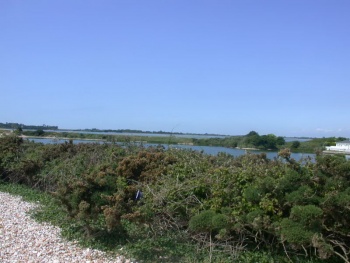
Photo by delia todd
Looking across the lagoon northwest to Pagham Harbour, June 2003
[Map]Pagham Lagoon, now enclosed, was once an entrance to the harbour and although now suffers from much disturbance remains worth visiting in winter.
The Lagoon can also be reached from Church Lane or follow the sign to "The Sea". Continue until the junction and follow Beach Road to the car park.
There is a hide at the end of the spit giving good views over the harbour.
Access and Facilities
Pagham Harbour is reached on the B2415 Chichester to Selsey road from the A27 Chichester bypass. Continue to Sidlesham village and about 1km beyond is the information centre, car park and toilets. Walk south to a hide overlooking the Ferry Pool which has disabled access. Further on are footpaths to Church Norton, either along the rife or the sea-wall and further still is the shingle beach and the reedbed fringed pools known as the Severals [Map].
For those in a hurry follow the Selsey road south of Sidlesham and turn off left, there is a car park at Church Norton.
There are footpaths north from the information centre and continuing round the harbour to Pagham Lagoon and the northern shingle spit.
Contact Details
Tel: 01243 641508
External Links
Maps
- Pagham Harbour on Streetmap
- Sidlesham Ferry on Streetmap
- Church Norton on Streetmap
- North Wall on Streetmap
- Pagham Lagoon on Streetmap
- The Severals on Streetmap
GSearch checked for 2020 platform.
Content and images originally posted by Steve
Reviews
markfalconer's review
A very natural area with a good variety of wildlife. Good scopes needed as cover is limited and a lot of activity is at distance. We only spent a couple of hours here but needed much longer. Flat and open so be prepared in inclement weather. Well worth a visit at the right time of year. Pros
- Good info at visitors centre. Toilets. car parking. Free to all. Good footpaths.
kevster43's review
Pagham Harbour-25th October 2005
After arriving at the visitors centre at 9pm and checking out the Ferry Pool where I saw Teal and Shelduck, I made my way out on to the reserve stopping at a simple wooden bench overlooking a vast area of exposed mud-flat. Here I sat for an hour or 2 huddled over my scope. The wind was blowing at my back so hard that I could use the hood of my blue rain coat to keep the horizontal rain off the eyepiece. I must have looked odd sitting there on my own. I have to admit it was slightly surreal what with the bad weather and not seeing anyone else around, just Grey Plovers speeding past. By lunch the sun was just breaking through and I walked on to the hide near Church Norton where I met a husband and wife enjoying the birds. After chatting to them for a few minutes it turns out that not only do they live near me but we share the same local patch! Small world. From the hide I saw hundreds of Waders including Oystercatchers, Common Sandpiper and Knot. Then on to the Severals where I watched Curlew, Little Egret and Redshank. By now it was 1pm and as I walked across the shingle to the very rough and choppy English Channel there, a few meters off-shore were 4 Red-Breasted Merganser and 2 G.C Grebe. My first visit to Pagham was very memorable and hopefully one of many. Below is the list for that day. I know some may say not many... I�m a crap birder but give me time: Avocet, B.H. Gull, Bar-Tailed Godwit, Blackbird, Brent Goose, Carrion Crow, Common Sandpiper, Cormorant, Curlew, G.B.B. Gull, G.C. Grebe, Goldfinch, Greenfinch, Green Woodpecker, Grey Heron, Grey Plover, Herring Gull, Kestrel, Knot, L.B.B Gull, Lapwing, Little Egret, Little Grebe, Magpie, Mallard, Mute Swan, Oystercatcher, Pheasant, Red-Breasted Merganser, Redshank, Robin, Shelduck, Skylark, House Sparrow, Starling, Teal, Turnstone, Widgeon, Wood Pigeon.
Pros
- Just a nice reserve.
Cons
- None I can think of.
teamsaint's review
There is always something to see Pagham. On our last visit we had Wheatears hopping right up to us whilst we were eating our lunch. Also this is the best site in the region for Curlew Sandpiper and Little Stint plus there are also Avocet & Spotted Redshnak.
Pros
- really good selection of birds in a variety of habitats.
Cons
- none that i can think of




